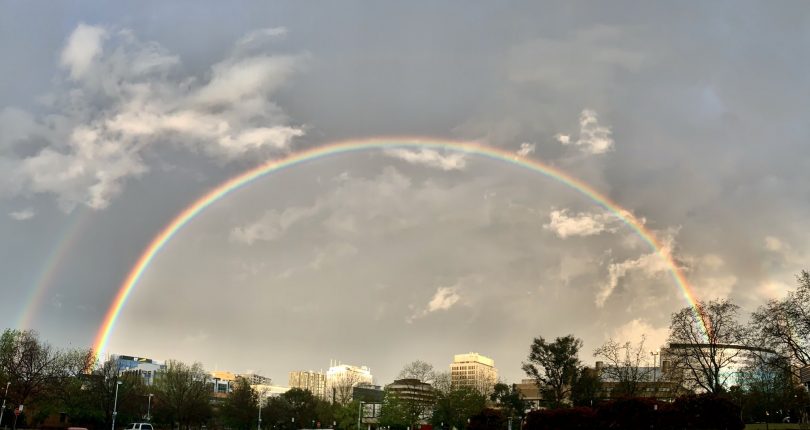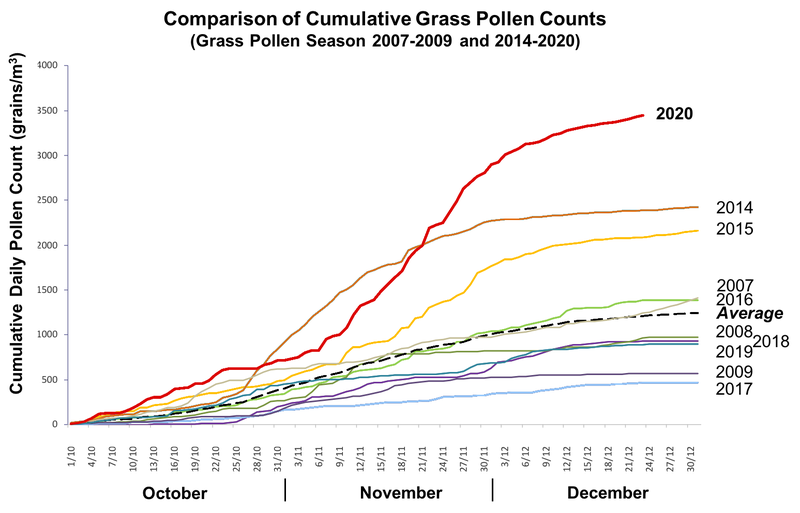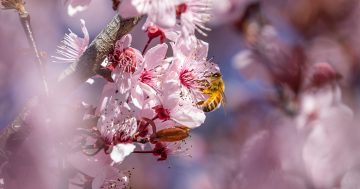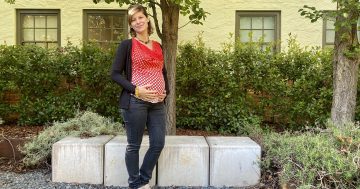
Canberrans can bid farewell to the longest and strongest pollen season on record. Photo: Canberra Pollen Twitter.
Canberrans can finally breathe a collective sigh of relief!
The longest and strongest pollen season ever seen in the ACT is having its last gasp with pollen counts almost negligible and forecast to stay that way until July.
While the so-called ‘big sneeze’ of spring and summer had Canberrans reaching for the tissues and antihistamines, the sneeze and wheeze season continued thanks to a wet summer and a far-from-sporadic number of spores in the air.
Canberra’s pollen counter and researcher with the ANU’s School of Culture, History and Language, Professor Simon Haberle, said lower temperatures will put an end to the hay fever season, and we should be free of significant allergenic pollen until July.
Professor Haberle, who also runs pollen monitoring website Canberra Pollen and the Canberra Pollen App, said the end of the longest and strongest hay fever season in Canberra is just around the corner.
“We’ve been monitoring the air quality in Canberra for 10 years or so, and we’re now entering a really low period of pollen production in March,” he said.
“That will end with the spores from the Chinese elm and casuarina, which is the last of the allergenic tree pollen to be produced in our region.
“This year, we’ve seen those two trees produce higher amounts of pollen, especially the casuarina which is still producing high pollen. This is why some people will still be suffering from asthma and hay fever.”

Canberra’s grass pollen counts for the periods of 2007-2009 and 2014-2020. Image: Canberra Pollen.
Canberra’s has a reputation as the pollen capital of Australia, and the city saw a pollen season of record levels of grass pollen following prolonged periods of rain and a slightly milder than average summer that saw green grasses on every side of the fence.
The season also had high amounts of pollen from birch and elm trees, along with large amounts of Paterson’s curse, a purple-flowering weed that proliferated on paddocks and hillsides.
“Because we’ve had such a warm and wet season, that’s been the main cause of a longer and stronger pollen season,” said Professor Haberle.
“We’ll have some reprieve until July when some of the winter flowering trees, such as the various species of pine, start up again.”
The end of the pollen season comes as two researchers from the ANU discovered that the key to stopping allergic conditions lies with a natural response deep within the immune system that is driven by a protein in the body called neuritin.
For people with allergies, when the immune system overreacts to allergens – such as pollen, dust or peanuts – it produces antibodies called Immunoglobulin E (IgE). The researchers found an excessive amount of neuritin in the immune systems of people who didn’t suffer from allergies.
Professor Carola Vinuesa said their findings could lead to a completely new approach to treat allergies and autoimmune diseases.
“If this approach is successful, we would not need to deplete important immune cells nor dampen the entire immune system,” said Professor Vinuesa. “Instead, we would only need to use the proteins our own body uses to ensure immune tolerance.”
Professor Haberle said during the past weekend, he recorded some high amounts of casuarina pollen but anticipates this will subside with lower temperatures this week. Canberra also shivered through its coldest March day on record on Sunday, 14 March, with a maximum temperature of only 15.9 degrees.
“April, May and June are really the three months when Canberra is free of any bad pollen, but we’ll keep monitoring just to see if any of that changes,” he said.
Professor Haberle also said there is no doubt that climate change is also having an impact on the pollen season.
“We expect our climate is going to change significantly so periods of high rainfall and dry years will also change our air quality quite significantly, either through pollen or smoke particles which we’ve experienced during the past couple of years.”















